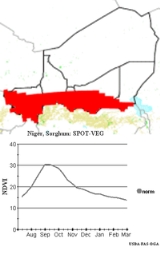
Agriculture in Niger
Encyclopedia
Agriculture
is the primary economic activity of a majority of Niger
's 13 million citizens.
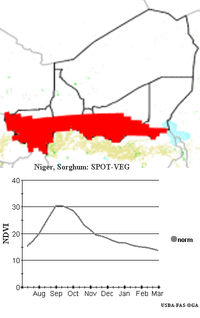
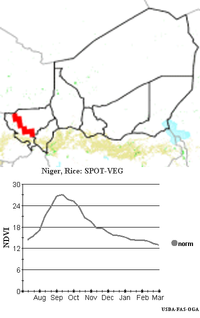 The agricultural economy is based largely upon internal markets, subsistence agriculture, and the export of raw commodities: food stuffs and cattle to neighbors. Niger
The agricultural economy is based largely upon internal markets, subsistence agriculture, and the export of raw commodities: food stuffs and cattle to neighbors. Niger
, a landlocked Sub-Sahara African nation, and over the past two decades has consistently been ranked near or at the bottom of worldwide indexes of the Human development index
, GDP, and percapita income. Economic activity centres on subsistence agriculture, animal husbandry, re-export trade, and export of uranium
. The 50% devaluation of the West African CFA franc
in January 1994 boosted exports of livestock
, cowpea
s, onion
s, and the products of Niger's small cotton
industry. Exports of cattle to neighboring Nigeria
, as well as Groundnuts and their oil remain the primary non-mineral exports.
cycles, desertification
, a 3.4% population growth rate and the drop in world demand for uranium have undercut an already marginal economy. Traditional subsistence farming, herding, small trading, and informal markets dominate an economy that generates few formal sector jobs. Between 1988 and 1995 28% to 30% of the total economy of Niger was in the unregulated Informal sector, including small and even large scale rural and urban production, transport and services. Current GDP per capita is very low by world standards, in part explained through the involvement of a majority of the population in very small scale agriculture, which generates little monetary exchange.
) which can expect to receive between 300mm to 600mm of rainfall annually. A small area in the southern tip of the nation, surrounding Gaya
can expect to receive 700mm to 900mm or rainfall. Northern areas which support crops, such as the southern portions of the Aïr Massif and the Kaouar oasis rely upon oases and a slight increase in rainfall due to mountain effects. Large portions of the northwest and far east of the nation, while within the Sahara desert, see just enough seasonal rainfall to support semi-nomadic animal husbandry. The populations of these areas, mostly Tuareg, Wodaabe
- Fula
, and Toubou
, practise Transhumance
: traveling south to pasture and sell animals in the dry season, north into the Sahara in the brief rainy season, while maintaining settled communities along these routes.
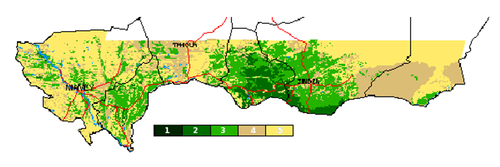
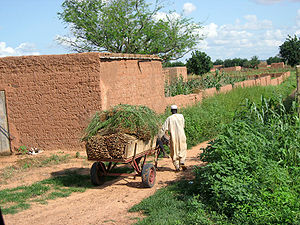 Niger's agricultural and livestock sectors are the mainstay of all but 18% of the population. Fourteen percent of Niger's GDP is generated by livestock production (camels, goats, sheep and cattle), said to support 29% of the population. Thus 53% of the population is actively involved in crop production. The 15% of Niger's land that is arable is found mainly along its southern border with Nigeria.
Niger's agricultural and livestock sectors are the mainstay of all but 18% of the population. Fourteen percent of Niger's GDP is generated by livestock production (camels, goats, sheep and cattle), said to support 29% of the population. Thus 53% of the population is actively involved in crop production. The 15% of Niger's land that is arable is found mainly along its southern border with Nigeria.
Pearl millet
, sorghum, and cassava are Niger's principal rain-fed subsistence crops. Irrigated rice for internal consumption, while expensive, has, since the devaluation of the CFA franc, sold for below the price of imported rice, encouraging additional production. Cowpeas and onions are grown for commercial export, as are small quantities of garlic, peppers, potatoes, and wheat.
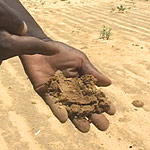
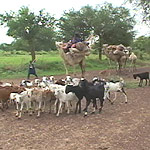 Rainfall varies and when insufficient, Niger has difficulty feeding its population and must rely on grain purchases and food aid to meet food requirements. Rains, as in much of the Sahel
Rainfall varies and when insufficient, Niger has difficulty feeding its population and must rely on grain purchases and food aid to meet food requirements. Rains, as in much of the Sahel
, have been marked by annual variability. This has been especially true in the 20th century, with the most severe drought on record
beginning in the late 1960s and lasting, with one break, well into the 1980s. The long term effect of this, especially to pastoralist populations remains in the 21st century, with those communities which rely upon cattle, sheep, and camels husbandry losing entire herds more than once during this period. Recent rains remain variable. For instance, the rains in 2000 were not good, those in 2001 were plentiful and well distributed.
Food shortfalls have also been caused by other factors. Market prices driven up by drought
and a plague of desert locust
in 2005-2006 caused a major food crisis in parts of the nation.
Shortage of good farmland has led to a number of innovations to farm marginal, often laterite
soils and soil degraded by overfarming, wind, desertification
, and drought. Women in particular are often given poor plots of land (in inherited sections known as "Gamana") to garden, and have developed specific crops for poor soil and water conditions. These include the fruit of the Ziziphus mauritania tree ("Indian Jujube", known locally as "Pomme du Sahel" or Sahel Apple) and the leaves and nuts of the Moringa stenopetala
. Farmers use specialty water conservation techniques, "water microcatchments" or planting pits known as zai holes, planting of crops among certain trees, planting in raised beds, drip irrigation
, and usage of water collected in the natural stone bottomed low areas common in the south east of the nation.
outside the marketplace. The 2006 Human Development Index
ranked Niger sixth from worst in the world, with a HDI of 0.370: 174 of 179 nations.
Groundnuts, and to a lesser degree Cotton
, introduced by former colonial power France in the 1930s and 1950s respectively, account for most of the world market for Nigerien industrial agriculture. Prior to the mass exploitation of uranium in the early 1970s, groundnut oil was the largest Nigerien export by worth.
areas in the south center of the nation are especially known for their leather industries. Zinder
and Maradi are two foci of leatherwork and trade.
Agriculture
Agriculture is the cultivation of animals, plants, fungi and other life forms for food, fiber, and other products used to sustain life. Agriculture was the key implement in the rise of sedentary human civilization, whereby farming of domesticated species created food surpluses that nurtured the...
is the primary economic activity of a majority of Niger
Niger
Niger , officially named the Republic of Niger, is a landlocked country in Western Africa, named after the Niger River. It borders Nigeria and Benin to the south, Burkina Faso and Mali to the west, Algeria and Libya to the north and Chad to the east...
's 13 million citizens.


Niger
Niger , officially named the Republic of Niger, is a landlocked country in Western Africa, named after the Niger River. It borders Nigeria and Benin to the south, Burkina Faso and Mali to the west, Algeria and Libya to the north and Chad to the east...
, a landlocked Sub-Sahara African nation, and over the past two decades has consistently been ranked near or at the bottom of worldwide indexes of the Human development index
Human Development Index
The Human Development Index is a composite statistic used to rank countries by level of "human development" and separate "very high human development", "high human development", "medium human development", and "low human development" countries...
, GDP, and percapita income. Economic activity centres on subsistence agriculture, animal husbandry, re-export trade, and export of uranium
Uranium
Uranium is a silvery-white metallic chemical element in the actinide series of the periodic table, with atomic number 92. It is assigned the chemical symbol U. A uranium atom has 92 protons and 92 electrons, of which 6 are valence electrons...
. The 50% devaluation of the West African CFA franc
West African CFA franc
The West African CFA franc is the currency of eight independent states in West Africa: Benin, Burkina Faso, Côte d'Ivoire, Guinea-Bissau, Mali, Niger, Sénégal and Togo. The acronym CFA stands for Communauté financière d'Afrique...
in January 1994 boosted exports of livestock
Livestock
Livestock refers to one or more domesticated animals raised in an agricultural setting to produce commodities such as food, fiber and labor. The term "livestock" as used in this article does not include poultry or farmed fish; however the inclusion of these, especially poultry, within the meaning...
, cowpea
Cowpea
The Cowpea is one of several species of the widely cultivated genus Vigna. Four cultivated subspecies are recognised:*Vigna unguiculata subsp. cylindrica Catjang...
s, onion
Onion
The onion , also known as the bulb onion, common onion and garden onion, is the most widely cultivated species of the genus Allium. The genus Allium also contains a number of other species variously referred to as onions and cultivated for food, such as the Japanese bunching onion The onion...
s, and the products of Niger's small cotton
Cotton
Cotton is a soft, fluffy staple fiber that grows in a boll, or protective capsule, around the seeds of cotton plants of the genus Gossypium. The fiber is almost pure cellulose. The botanical purpose of cotton fiber is to aid in seed dispersal....
industry. Exports of cattle to neighboring Nigeria
Nigeria
Nigeria , officially the Federal Republic of Nigeria, is a federal constitutional republic comprising 36 states and its Federal Capital Territory, Abuja. The country is located in West Africa and shares land borders with the Republic of Benin in the west, Chad and Cameroon in the east, and Niger in...
, as well as Groundnuts and their oil remain the primary non-mineral exports.
Overall economy
Niger's economy is based largely on subsistence crops, livestock, and some of the world's largest uranium deposits. DroughtDrought
A drought is an extended period of months or years when a region notes a deficiency in its water supply. Generally, this occurs when a region receives consistently below average precipitation. It can have a substantial impact on the ecosystem and agriculture of the affected region...
cycles, desertification
Desertification
Desertification is the degradation of land in drylands. Caused by a variety of factors, such as climate change and human activities, desertification is one of the most significant global environmental problems.-Definitions:...
, a 3.4% population growth rate and the drop in world demand for uranium have undercut an already marginal economy. Traditional subsistence farming, herding, small trading, and informal markets dominate an economy that generates few formal sector jobs. Between 1988 and 1995 28% to 30% of the total economy of Niger was in the unregulated Informal sector, including small and even large scale rural and urban production, transport and services. Current GDP per capita is very low by world standards, in part explained through the involvement of a majority of the population in very small scale agriculture, which generates little monetary exchange.
Geography
A majority of Niger's population rural residents engaged in crop tending are clustered in the south centre and south west of the nation, in those areas (the SahelSahel
The Sahel is the ecoclimatic and biogeographic zone of transition between the Sahara desert in the North and the Sudanian Savannas in the south.It stretches across the North African continent between the Atlantic Ocean and the Red Sea....
) which can expect to receive between 300mm to 600mm of rainfall annually. A small area in the southern tip of the nation, surrounding Gaya
Gaya, Niger
Gaya is a city in the Dosso Region of Niger. The city is situated 254 km southeast of the capital, Niamey, is located on the banks of the Niger River, and is near the borders with Benin and Nigeria. Gaya has a population of 28,385 . The wettest area in Niger, Gaya averages 800 mm in...
can expect to receive 700mm to 900mm or rainfall. Northern areas which support crops, such as the southern portions of the Aïr Massif and the Kaouar oasis rely upon oases and a slight increase in rainfall due to mountain effects. Large portions of the northwest and far east of the nation, while within the Sahara desert, see just enough seasonal rainfall to support semi-nomadic animal husbandry. The populations of these areas, mostly Tuareg, Wodaabe
Wodaabe
The Wodaabe or Bororo are a small subgroup of the Fulani ethnic group. They are traditionally nomadic cattle-herders and traders in the Sahel, with migrations stretching from southern Niger, through northern Nigeria, northeastern Cameroon, and the western region of the Central African Republic....
- Fula
Fula people
Fula people or Fulani or Fulbe are an ethnic group spread over many countries, predominantly in West Africa, but found also in Central Africa and Sudanese North Africa...
, and Toubou
Toubou
The Tubu are an ethnic group that live mainly in northern Chad, but also in Libya, Niger and Sudan....
, practise Transhumance
Transhumance
Transhumance is the seasonal movement of people with their livestock between fixed summer and winter pastures. In montane regions it implies movement between higher pastures in summer and to lower valleys in winter. Herders have a permanent home, typically in valleys. Only the herds travel, with...
: traveling south to pasture and sell animals in the dry season, north into the Sahara in the brief rainy season, while maintaining settled communities along these routes.

Agriculture production

Pearl millet
Pearl millet
Pearl millet is the most widely grown type of millet. Grown in Africa and the Indian subcontinent since prehistoric times, it is generally accepted that pearl millet originated in Africa and was subsequently introduced into India. The center of diversity, and suggested area of domestication, for...
, sorghum, and cassava are Niger's principal rain-fed subsistence crops. Irrigated rice for internal consumption, while expensive, has, since the devaluation of the CFA franc, sold for below the price of imported rice, encouraging additional production. Cowpeas and onions are grown for commercial export, as are small quantities of garlic, peppers, potatoes, and wheat.
Drought and environmental degradation


Sahel
The Sahel is the ecoclimatic and biogeographic zone of transition between the Sahara desert in the North and the Sudanian Savannas in the south.It stretches across the North African continent between the Atlantic Ocean and the Red Sea....
, have been marked by annual variability. This has been especially true in the 20th century, with the most severe drought on record
Sahel drought
[[File:Greening Sahel 1982-1999.jpg|thumb|300px|Recent "Greening" of the Sahel: The results of trend analyses of time series over the Sahel region of seasonally integrated NDVI using NOAA AVHRR NDVI-data from 1982 to 1999...
beginning in the late 1960s and lasting, with one break, well into the 1980s. The long term effect of this, especially to pastoralist populations remains in the 21st century, with those communities which rely upon cattle, sheep, and camels husbandry losing entire herds more than once during this period. Recent rains remain variable. For instance, the rains in 2000 were not good, those in 2001 were plentiful and well distributed.
Food shortfalls have also been caused by other factors. Market prices driven up by drought
Drought
A drought is an extended period of months or years when a region notes a deficiency in its water supply. Generally, this occurs when a region receives consistently below average precipitation. It can have a substantial impact on the ecosystem and agriculture of the affected region...
and a plague of desert locust
Desert locust
Plagues of the desert locust have threatened agricultural production in Africa, the Middle East, and Asia for centuries. The livelihood of at least one-tenth of the world’s human population can be affected by this voracious insect...
in 2005-2006 caused a major food crisis in parts of the nation.
Shortage of good farmland has led to a number of innovations to farm marginal, often laterite
Laterite
Laterites are soil types rich in iron and aluminium, formed in hot and wet tropical areas. Nearly all laterites are rusty-red because of iron oxides. They develop by intensive and long-lasting weathering of the underlying parent rock...
soils and soil degraded by overfarming, wind, desertification
Desertification
Desertification is the degradation of land in drylands. Caused by a variety of factors, such as climate change and human activities, desertification is one of the most significant global environmental problems.-Definitions:...
, and drought. Women in particular are often given poor plots of land (in inherited sections known as "Gamana") to garden, and have developed specific crops for poor soil and water conditions. These include the fruit of the Ziziphus mauritania tree ("Indian Jujube", known locally as "Pomme du Sahel" or Sahel Apple) and the leaves and nuts of the Moringa stenopetala
Moringa
Moringa is the sole genus in the flowering plant family Moringaceae. The name is derived from the Tamil word murunggai or the Malayalam word muringa, both of which refer to M. oleifera...
. Farmers use specialty water conservation techniques, "water microcatchments" or planting pits known as zai holes, planting of crops among certain trees, planting in raised beds, drip irrigation
Drip irrigation
Drip irrigation, also known as trickle irrigation or microirrigation or localized irrigation , is an irrigation method which saves water and fertilizer by allowing water to drip slowly to the roots of plants, either onto the soil surface or directly onto the root zone, through a network of valves,...
, and usage of water collected in the natural stone bottomed low areas common in the south east of the nation.
Market effects
While Nigerien farmers are often dependent on the agricultural market for portions of their production and consumption, much of Nigerien farming is subsistence agricultureSubsistence agriculture
Subsistence agriculture is self-sufficiency farming in which the farmers focus on growing enough food to feed their families. The typical subsistence farm has a range of crops and animals needed by the family to eat and clothe themselves during the year. Planting decisions are made with an eye...
outside the marketplace. The 2006 Human Development Index
Human Development Index
The Human Development Index is a composite statistic used to rank countries by level of "human development" and separate "very high human development", "high human development", "medium human development", and "low human development" countries...
ranked Niger sixth from worst in the world, with a HDI of 0.370: 174 of 179 nations.
Groundnuts, and to a lesser degree Cotton
Cotton
Cotton is a soft, fluffy staple fiber that grows in a boll, or protective capsule, around the seeds of cotton plants of the genus Gossypium. The fiber is almost pure cellulose. The botanical purpose of cotton fiber is to aid in seed dispersal....
, introduced by former colonial power France in the 1930s and 1950s respectively, account for most of the world market for Nigerien industrial agriculture. Prior to the mass exploitation of uranium in the early 1970s, groundnut oil was the largest Nigerien export by worth.
External trade and investment in agriculture
Of Niger's exports, foreign exchange earnings from livestock, although difficult to quantify, are second only to those from uranium. Actual exports far exceed official statistics, which often fail to detect large herds of animals informally crossing into Nigeria. Some hides and skins are exported and some are transformed into handicrafts. HausaHausa people
The Hausa are one of the largest ethnic groups in West Africa. They are a Sahelian people chiefly located in northern Nigeria and southeastern Niger, but having significant numbers living in regions of Cameroon, Ghana, Cote d'Ivoire, Chad and Sudan...
areas in the south center of the nation are especially known for their leather industries. Zinder
Zinder
Zinder is the second largest city in Niger, with a population of 170,574 by 2005 was estimated to be over 200,000...
and Maradi are two foci of leatherwork and trade.
External links
- Institut de Recherche pour le Développement au Niger: French government development office in Niger.
- United Kingdom Department of International Development:Niger.
- Canadian International Development Agency:Niger.
- World Trade Organization MEMBER INFORMATION: Niger.
- The World Bank, Niger overview and resources.
- West African Agricultural Market Observer/Observatoire du Marché Agricole (RESIMAO), a project of the West-African Market Information Network (WAMIS-NET), provides live market and commodity prices from fifty seven regional and local public agricultural markets across Benin, Burkina Faso, Côte d'Ivoire, Guinea, Niger, Mali, Senegal, Togo, and Nigeria. Sixty commodities are tracked weekly. The project is run by the Benin Ministry of Agriculture, and a number of European, African, and United Nations agencies.
- OECD / AEO 2007 Niger country study.

